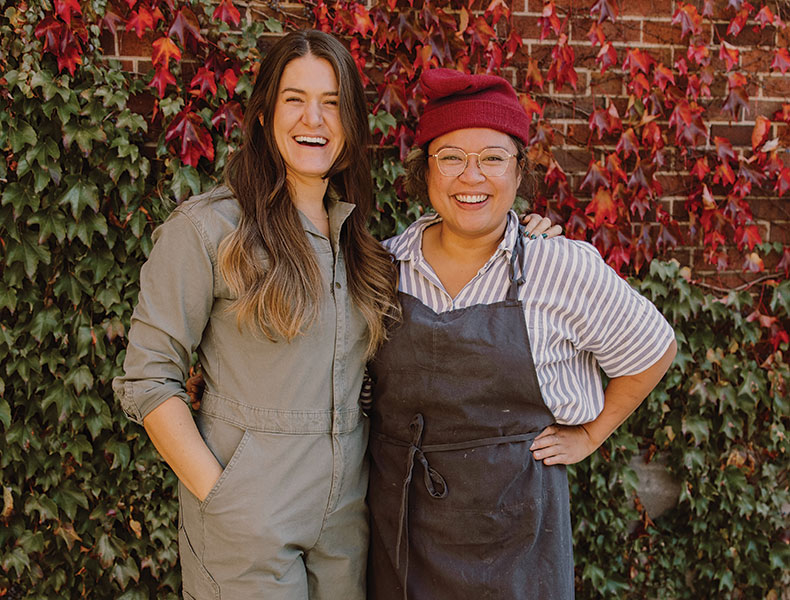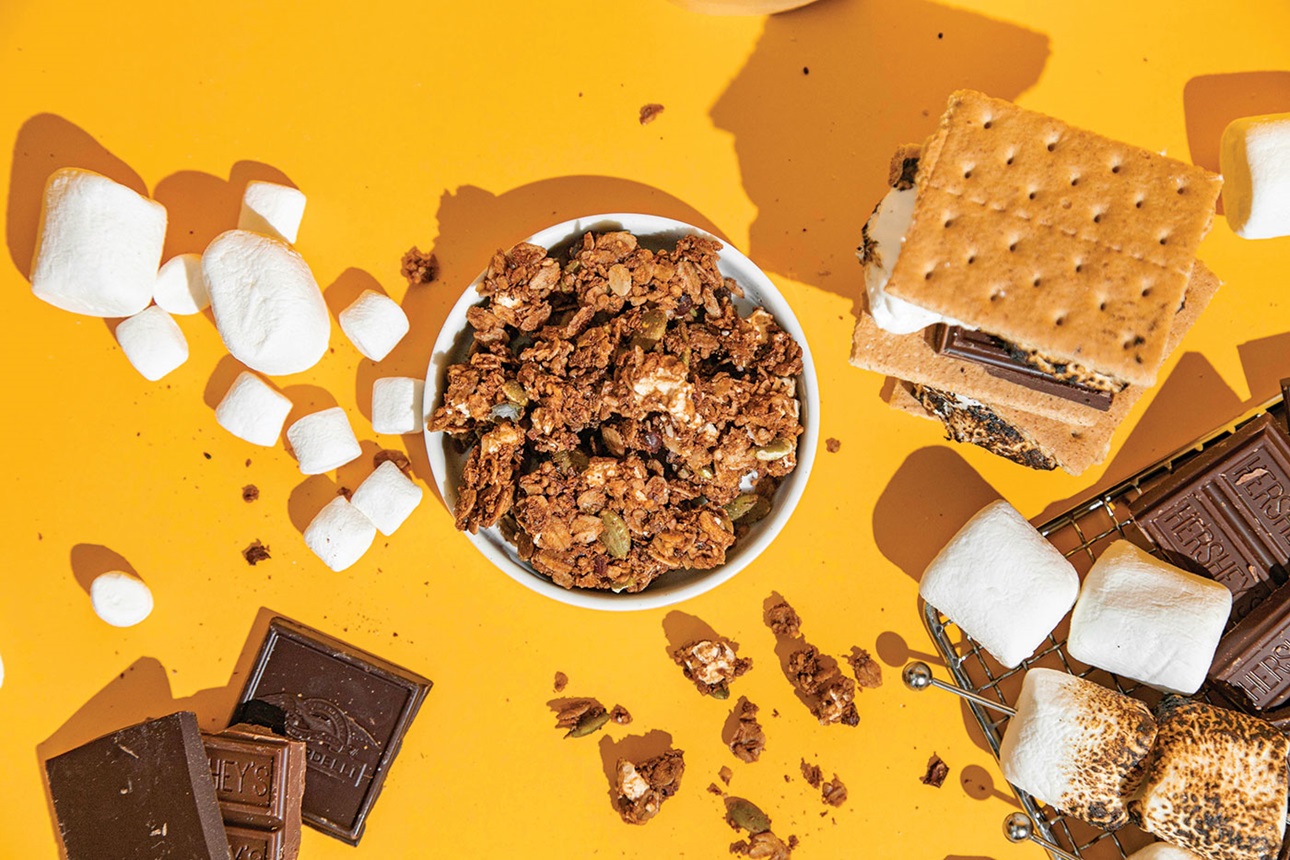A Stellar Startup
R&D Chefs Chrissy Camba and Emily Knapp discuss the ins and outs of starting a granola company—from product development challenges to plans for scaling up.

Both R&D chefs at Tovala, Emily Knapp (left) and Chrissy Camba launched Stellar Granola in 2020. Photo courtesy of Stellar Granola
Chrissy Camba and Emily Knapp met at Chicago-based Tovala, maker of the Smart Oven and chef-crafted meals, where Camba is lead R&D chef and Knapp is senior R&D chef. They immediately clicked and knew they wanted to start a business together but weren’t sure what it should be. They batted around ideas until, during the pandemic, Camba was playing around with making granola in the Smart Oven.
Knapp quickly noted that there weren’t a lot of allergen-free granolas available, so with the support of their current boss (who also became a customer), they launched Stellar Granola. “I specialize in vegan and vegetarian cuisine. That is my bread and nondairy butter,” Knapp jokes about her focus. The company now makes gluten-, dairy-, and nut-free granolas in unusual flavors (including a new savory Everything Bagel granola). Stellar Granola was profitable from the beginning, starting small and selling by mail order, at-home delivery in Chicago, and through specialty shops.
Food Technology talked to cofounders Camba and Knapp about bootstrapping a startup, 16-hour days, granola as a salad topper, and what they need next to expand.
How did you know you wanted to work together?
Camba: It’s like when you put a piece in a puzzle, when your weaknesses are someone else’s strengths. I like it when things are exciting, figuring out when it will happen. I really like taking high risks. Emily is the rational one.
Stellar Granola has some cool varieties, such as S’mores, Golden Milk, Cinnamon Toast, and Everything Bagel. How did you come up with them?
Knapp: We have four core flavors [The OG, S’mores, Cinnamon Toast, and Golden Milk]. And then we launch limited-edition flavors, which are seasonal, probably once a quarter. Those are Chrissy’s love children. We try to get people to think differently about granola. It’s a more playful perspective of what granola can be. It can be a salad topper. You can put it on your eggs. You can put it on toast. You don’t only have to eat it with yogurt and on top of smoothies anymore. You can have it at any time of the day.
Camba: I go by feeling because I worked in the restaurant industry and your body just gets in tune with the seasons. I wouldn’t [do] something decadent in the middle of July because no one in Chicago is going to want to eat that. It really depends on the flavor. Triple Berry Pie took me at least 12 or 15 versions. When you’re incorporating ingredients such as blueberries that have more water content and you’re still trying to cook it out, it changes the texture. So I had to go through a lot of options: Should I make this into a puree? Should I get some dehydrated or frozen or freeze-dried berries? Then Emily tastes them at the end. And if she doesn’t like it, I get a little frustrated because I’m like, “This is the twelfth one!” And then I go away and come back and say, “You’re right.”
Knapp: We do nostalgic flavors tied to a core memory. With Triple Berry Pie I tasted it and said, “This is fine. It has berries in it. People are going to like it.” And she said, “It doesn’t taste like a blueberry is bursting in your mouth, like when you eat a pie, and it bursts in your mouth. We should have the juiciness to do that.” And I asked, “We’re creating a dry granola. How are you going to create this?” And she did it. We threw lemon zest in there and she was exactly right.
To know what people are nostalgic for, you have to know who they are. Who are your customers?
Knapp: We have an interesting clientele because we still have a relatively small pool who we talk to regularly. They tend to be people in our age group who have similar lifestyles who want to eat healthy, but also love the idea of it not tasting healthy. Also, because we are allergen-friendly, a lot of kids like us as well. Kids love things that [taste] like pie and cookies. Most of our clients are 30 to 45 years old. We have parents as customers because they gave it to their kids, and then they get hooked on it themselves.
Are you making the granola yourselves?
Knapp: We’re doing everything. We’re making the granola, packaging it, sticking stickers on it, and shipping it out or delivering in Chicago.
How long does that take you, in addition to your other full-time jobs at Tovala?
Knapp: We make it in a 16-hour day.
Does that limit how much granola you can sell?
Camba: Yes. We can only do so much in the time we have because we rent a shared kitchen on an hourly basis. There’s only so much time in both of our schedules and time in the kitchen. And how much we can pack. Our maximum is 600 units, that’s 300 pounds in a 16-hour day.
It sounds like a pretty well-oiled machine to do that in one long day. Was it like that from the beginning?
Knapp: The first month of production I had a COVID scare, so I couldn’t be there. The second month, all of our packaging was stolen. So, the day of production we had to reprint all of our packaging. Luckily, we had bags and we just had to reprint the stickers to sticker all the bags, but that’s an extra eight-hour process of stickering bags. The first two months were, “What are we doing? Why is everything that we plan on going wrong?” I’m a little bit more like, “I created a perfect plan and if it doesn’t go my way I’m going to be annoyed.” And Chrissy is very much like, “Cool. Who cares?”
Camba: I have an end goal; no plan.
Knapp: It was kind of a blessing in disguise in that those things early on solidified that Chrissy and I are good partners together for this and that as things get harder and as this company continues to grow, there’s nothing we can’t take on.
That’s a lot of work. Are you considering getting a co-packer?
Camba: I really want to move to a co-packer! It’s really hard to find a co-packer. And I don’t think our numbers are there to warrant it yet. That’s the big leap. In order to get a co-manufacturer you have to hit a minimum. But then how can you make that jump from what you’re currently doing with two people to making pallets of granola?
It sounds like a catch-22.
Knapp: Yes, some of the minimums are 12,000 units per flavor, and we don’t sell that in a year. There needs to be a small-man [small-scale manufacturing] co-packer.
Camba: But there’s not. Maybe someone will tell us of one.
Maybe that’s the next business you should start.
Knapp: Exactly.ft





